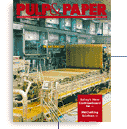
Meeting Canada’s challenges
We have all shared the pleasure —and the pain—of leading a company within our very competitive industry. As Chairman of the CPPA this past year, I have viewed our industry from a different perspective.
It was a great learning experience for me as I was given a different vantage point from which to make the following predictions:
• I see our industry growing stronger.
• I see us meeting the challenge of profitability.
• I see us regaining a place of dominance in the world forest products industry.
Why am I so optimistic? Well, let’s take a quick snapshot. As we look forward, we see healthy, growing markets and a supply demand balance that will deliver profitability. But the challenge our industry faces is not to take these profitable upswings to weather the next downturn, but rather to build—or actually rebuild—an industry that can extend its horizon beyond the next couple of cycles.
I truly feel that Canada, unfortunately, is now a little behind in the game. The problems we faced in the late 1980’s and through the mid-1990’s resulted in other producing nations leap-frogging over us to take center-stage in the global industry. Fortunately, we can catch up. We can strengthen our position here and abroad, regain a leadership role in the global expansion of our industry, and sustain the confidence of our shareholders. But we have to do our part to make it happen.
In my view, of the challenges we have ahead of us to achieve these goals, there are three that I would like to underline.
First, we must meet the challenge of continuing to consolidate our highly fragmented industry and gain the critical mass required in this global economy.
Second, we need to continue to look at each of our manufacturing facilities, rationalizing those which cannot compete over the long-term, and introduce new technologies to those which do have the potential.
Finally, we absolutely must push for a far more competitive tax structure to put us on a level playing field with our major competition.
Consolidation is healthy for our industry and healthy for our shareholders. There is too much fragmentation in almost every product line in our industry.
Some of our oldest machines date back to the 20’s and 30’s, and many are finding it increasingly difficult to ride out the waves of our extreme cycles. We need to find an effective way of retiring the highest-cost machines, and take the marginally profitable machines and make intelligent investments that use the unique properties of our northern fiber to produce products that are in growing demand.
It is always difficult—on all stakeholders—to rationalize capacity. However, we must focus investment on the most deserving mills.
Canada has undeniably the best quality pulp in the world. Global shares of the market for value-added products which demand this quality pulp are surely changing, so let’s take advantage of this.
Some in this country would have us believe that free market supremacy is transforming Canada from a social nation to a corporate nation state. That Canada’s companies have effectively taken control of the public policy agenda.
From where I sit, nothing could be further from the truth. As a leading economic contributor to Canada, our industry is actually a target for the wealth creation of the rest of the nation.
We have the highest stumpage rates in the world. Canada’s paper industry is the highest taxed of any of our competing nations, and our employees are hit with a triple whammy! They are impacted by our corporate tax, they are hit again with high personal income taxes, and as shareholders, they are hit yet again with a capital gains tax. No wonder so many of them are foregoing employment here and heading south.
Who hasn’t faced difficulty attracting talent across the border into Canada or keeping some of our bright lights here and encouraging them to work for an industry that is perceived as low-tech...is treated as low-tech, but is anything but.
We need a public policy framework in Canada that is competitive with our trading partners.
We don’t advocate new spending—this country must continue to focus on reducing the debt as it has been in recent years. There can be no doubt that this present government has stayed the course on deficit reduction. This in turn has restored confidence in the strength of the Canadian economy. The Finance Minister, however, is under pressure from all quarters of society to loosen the purse strings and spend the forecasted surplus.
With a competitive and balanced economic infrastructure, and continued discipline, the Canadian pulp and paper sector can regain its once heralded status around the world. And then we can reward our patient shareholders with more consistent benefits that will, in turn, allow us to fuel our growth.
These predictions, I believe, can be made our reality.

|




